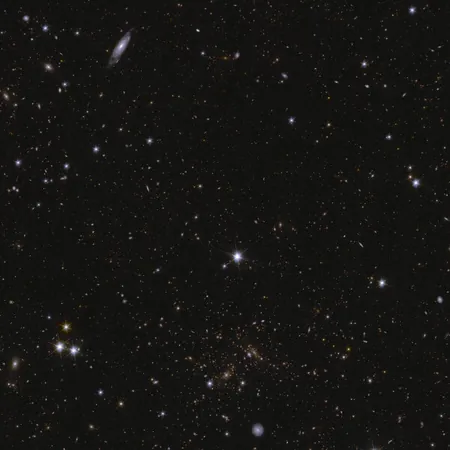
Breakthroughs in Cosmic Science: The Euclid Mission Sheds Light on Dark Matter
2025-04-04
Author: Arjun
In an exciting leap for astrophysics, the European Space Agency's Euclid mission is making groundbreaking contributions to our understanding of dark matter and dark energy. With pioneering research led by UK scientists, the project is unveiling a treasure trove of cosmic secrets that could change our perception of the universe.
Recent findings from the mission have identified 500 galaxies exhibiting strong gravitational lensing effects. This phenomenon occurs when the gravity of closer galaxies bends the light from more distant objects, offering a unique window into the elusive dark matter that permeates our universe. The implications of these discoveries are profound, as they provide new ways to study the composition and behavior of cosmic structures.
Revolutionizing Gravitational Studies
Launched in July 2023, Euclid is equipped with a sophisticated visible imager funded by a £37 million investment from the UK Space Agency. This cutting-edge 609-megapixel camera allows researchers to observe billions of galaxies that are as far as 10 billion light-years away. The data gathered includes not only distant galaxies but also transient cosmic events such as supernovae and gamma-ray bursts, enabling an unprecedented level of detail in the study of these celestial phenomena.
UK Science Minister Lord Vallance emphasized the critical role of the UK space sector in driving the mission's success. He remarked, “The advanced imaging technology and data processing tools from the UK are central to Euclid’s operations. The breakthroughs from this mission will deepen our cosmic knowledge while simultaneously enhancing data analysis capabilities that have real-world applications on Earth.”
A Collaborative Effort: Citizen Science and AI Unite
The success of Euclid's mission is a testament to the power of collaboration between artificial intelligence and citizen scientists. Over 1,000 volunteers utilized the Zooniverse platform to assist in analyzing images, resulting in the identification of 500 new gravitational lenses—effectively doubling the previously known count.
Dr. Aprajita Verma from the University of Oxford shared her excitement about the early results: “This initial data highlights Euclid’s extraordinary potential. Even with just a fraction of the survey area explored, we have uncovered millions of galaxies with stunning clarity.”
A Bright Future for Cosmic Exploration
The contributions from UK institutions, including the Mullard Space Science Laboratory, XCAM Ltd., and Teledyne Space Imaging, have been essential to Euclid's mission. Professor Mike Lockwood, President of the Royal Astronomical Society, stated, “Euclid is just beginning. With every new release of data, we inch closer to solving some of the greatest mysteries of our universe—its very fabric, its evolution, and what lies ahead for it.”
As we stand on the brink of significant discoveries, the combination of cutting-edge technology and collaborative efforts in research signals a new era in cosmic exploration. The implications of the Euclid mission could not only redefine our understanding of dark matter and energy but also enhance various scientific fields and technologies on our planet. Stay tuned for more updates as we unlock the secrets of the universe together!




 Brasil (PT)
Brasil (PT)
 Canada (EN)
Canada (EN)
 Chile (ES)
Chile (ES)
 Česko (CS)
Česko (CS)
 대한민국 (KO)
대한민국 (KO)
 España (ES)
España (ES)
 France (FR)
France (FR)
 Hong Kong (EN)
Hong Kong (EN)
 Italia (IT)
Italia (IT)
 日本 (JA)
日本 (JA)
 Magyarország (HU)
Magyarország (HU)
 Norge (NO)
Norge (NO)
 Polska (PL)
Polska (PL)
 Schweiz (DE)
Schweiz (DE)
 Singapore (EN)
Singapore (EN)
 Sverige (SV)
Sverige (SV)
 Suomi (FI)
Suomi (FI)
 Türkiye (TR)
Türkiye (TR)
 الإمارات العربية المتحدة (AR)
الإمارات العربية المتحدة (AR)